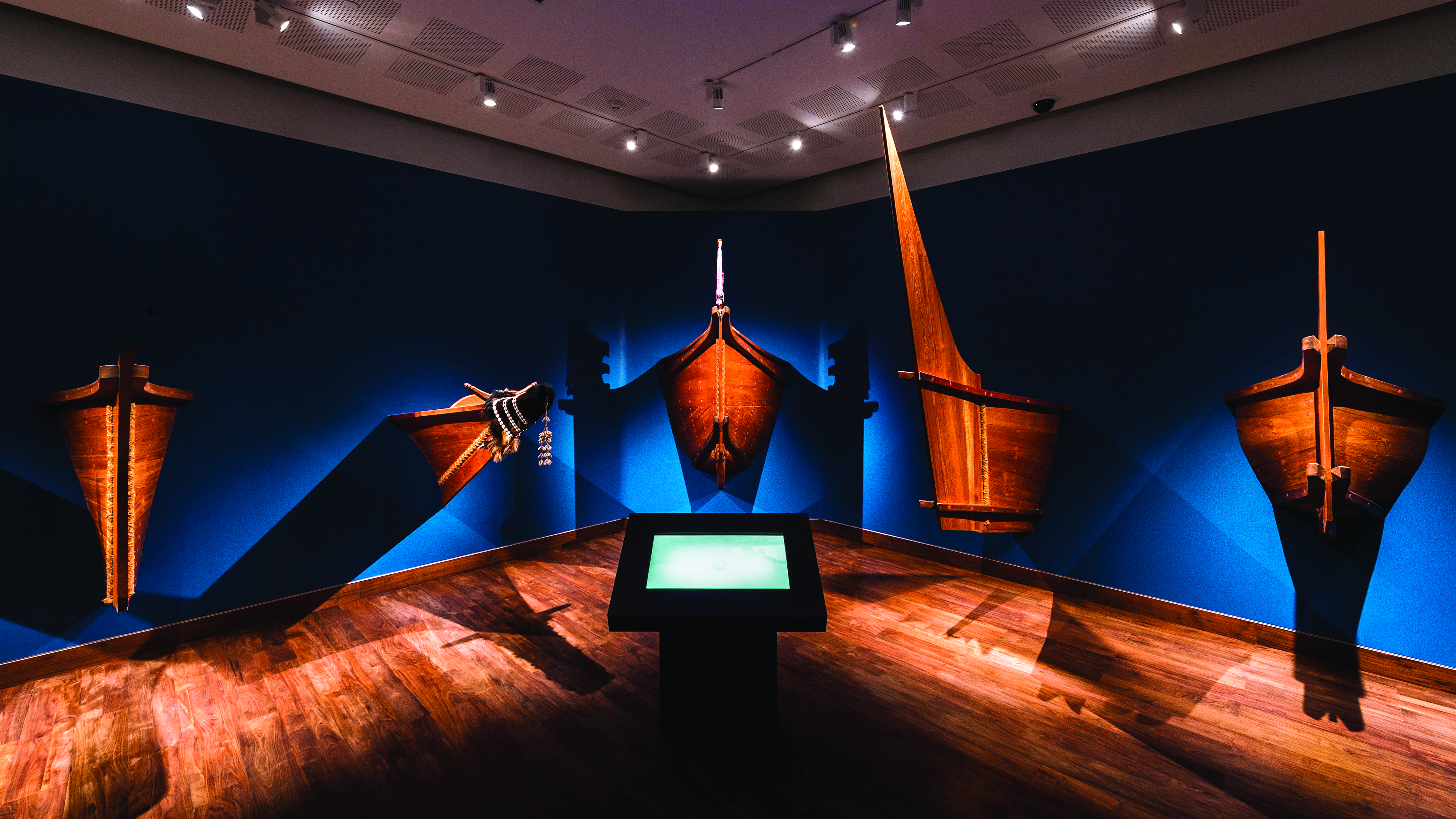
Architects, Curators, and Designers spent years developing the first museum in Oman to be established based on the International Council of Museum Standards. Housing more than 7,000 collectables across themed galleries, the 4,000 square metre space was designed with wide areas, spectacular light, and ample height to complement the well selected artefacts. The Museum’s upper level offers a majestic view of the Al Alam Palace, just across the roundabout, demonstrating an architectural vision of highlighting the history not only contained within the walls of this museum, but in its historic surroundings as well.
More than just a beautiful space, the museum is dedicated to incorporating modern technology to make it an interactive experience, with 43 digital interactive media devices, the first full UHD cinema in Oman, Arabic brail at every display, and open displays for direct interaction with the contents. With a fully-equipped learning centre, facilities for heritage preservation, and learning areas for children, the focus of this contemporary museum is on quality, education, and preservation. The result is an awe-inspiring place of dramatic views, spectacular ambiance, and immersive history.
After entering the Central Hall, visitors are encouraged to linger, taking in the artefacts including ancient chests, mandoos dowry boxes studded with metal and stone buttons, ancient utensils, two massive gates believed to have originally served as the main entrances for the Muscat Souq during the 14th century.
Turn left off of the centre court to enter the Maritime History Gallery. The wooden floored gallery has an enchanting ambiance with subtle lighting, housing seven small models of Omani ships and one big vessel, along with artefacts ranging from incense storage jars and maps depicting the old maritime routes, to ancient books and manuscripts on ship building technology, ship building tools and a stone anchor.
The journey continues to a circular, stone-paved hall that houses the Arms and Armour gallery, which traces the cultural aspects of traditional Omani weapons from prehistoric time to the beginning of the 20th century. Divided into two sections, the traditional Arms and Armour section houses swords, spears, battle axes, shields, arrows, archery tools, arrow head with shark teeth, flint drills and pins and Omani khanjars, while the gunpowder and artillery section exhibits firearms such as rifles, pistols, and cannons.
The design of the gallery is inspired by one of the two towers of Al Hazm Fort in South Al Batinah Governorate, which was built in the 17th century, and at the centre of the circular gallery is an amphitheatre, where HD shows are displayed in both Arabic and English on Oman’s military and cultural legacy. The gallery also features a series of shelves which can be pulled out for close-up inspections of items like rifles made by the Royal Small Arms Factory in 1294-95, which were used by the Al Busaid Dynasty.
The ground floor also houses The Land and the People Gallery, the Currency Gallery; and the Timeline Gallery, along with the Civilisation in the Making Gallery, which displays examples of architectural heritage beginning from the 3rd millennium BCE to the modern times, covering more than 5,000 years. In the Aflaj Gallery, the introduction of the al falaj system, which diverts groundwater for agricultural and domestic use, is attributed to King Solomon, who passed through Oman in ancient times. A three-metre interactive touch screen walks viewers through the scientific process behind the famed aflaj system in Birkat Al Mouz.
Archaeological pieces from various periods of Oman’s history are displayed on the walls along the ramp that leads up to the first floor, where visitors will find the Prehistory and Ancient History Gallery, whose highlights include a stone flint believed to be two million years old — the oldest man-made object found in Oman, and the first throne of His Majesty Sultan Qaboos bin Said Al Said from 1970. Also on the first floor, visitors will find the Oman and the World Gallery, the Renaissance Gallery, the Intangible Heritage Gallery, and the Splendours of Islam Gallery, which sheds light on Oman’s fourteen-hundred-year relationship with Islam, beginning in 627 CE, including the advent of Islam in Oman and the contributions made by Omani scholars to Islam as revealed through a collection of rare manuscripts. Another gallery section here traces the artistic influence of Islam in the evolution of calligraphic, geometric, floral, and arabesque decorations in the Sultanate.
Finish your visit at the ultra modern Collections Gallery, which features interactive multimedia devises that allow visitors to listen to Omani music, watch the videos of important events from Oman's Renaissance era, and interact with traditional musical instruments and artefacts via computer screens. With a growing collection and room after room of interactive displays, one visit to this museum will not be enough. This is a place to return to often to learn, reflect, and get inspired by the beauty and the history of both the building itself and the treasures it houses.